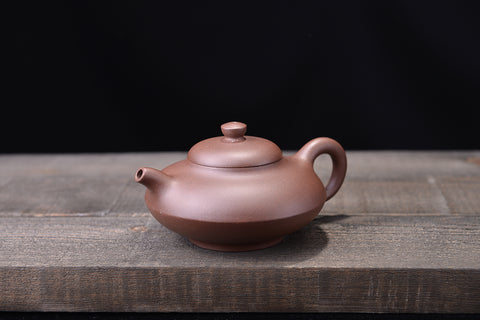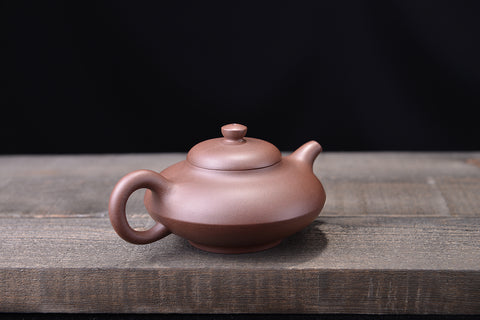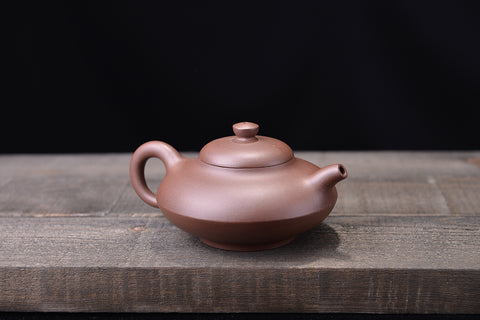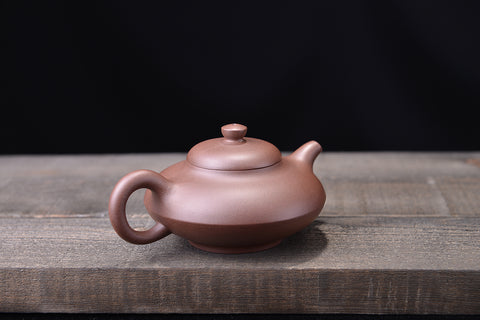
Breaking the sky to talk about purple sand: the basic knowledge of purple sand: pure handmade purple sand teapot
Share
Those who like to use purple clay teapots often say that it is inseparable from pure handwork and all handwork. Whether it is all handmade is also one of the criteria for judging the value of purple clay pots. Compared with mold pots, pure handmade purple sand pots are much more popular.
In fact, there have indeed been many excellent works in history that were formed with the help of molds. To put it bluntly, we do not reject mold pots. If we only hope to achieve difficult ideal effects with the help of molds, it is still within the acceptable range. There are two sayings that are good: 1. In Yixing, there are handmade pots that cost 100 yuan a piece, and molded pots that cost 150,000 yuan a piece. 2. I would rather choose a well-made mold pot than a poorly made handmade pot.

We seldom see purely hand-shaped purple sand pots at major tea tea set exhibitions or conferences, and it is even more difficult in tea houses on the side of the road. Many teapots sold by purple clay shops claim to be hand-made, but is this really the case ? Obviously not necessarily. There are many objective factors for not relying on purely handmade pots, but the main reasons are nothing more than two: 1. Increase productivity; 2. Handcrafted pots cannot achieve the desired effect in the plan if the skill is not enough.
That's right, there are more and more potters who are willing to make pure handmade pots. Experienced players all understand the reality that no matter how difficult or complex the pottery is, it can be done by pure handwork. In the pure handwork competition, even the difficult pot shape such as lifting the wall and closing the edge can also be completed by hand without the help of molds, but the time-consuming and finished products are different. To put it simply, all pot shapes can be made by hand, just whether you are willing to do it, or whether it is necessary to do so.

Many potters have said the same thing: within the time of opening a pair of molds, many pots can be finished by hand-made slices, but it takes a long time to assemble parts and repair the body with the help of molds. Time, the body punch is just a very simple basic step. As long as the work at hand is proficient enough, you can get a lot of boobs in a day. This statement is somewhat contradictory. Assuming that the hands-on skill is strong and the work is good enough and fast enough, why do we need to use molds? Obviously it can be done easily, but it takes a lot of time and labor to open the mold, and it is said that it can be done quickly, why? Everyone will know after analyzing it.
Zisha ware is an intangible cultural heritage of traditional Chinese handicrafts. It is understandable to use molds to make pumpkin pots, Bagua faucets with bundles of bamboo, or pots decorated with twisted mud in this link.

Many people are still unable to identify whether the traditional shape is purely hand-made. Here is a set of [Pure manual purple sand ware forming rules] for your reference, which is roughly as follows:
1. If the body is hand-molded, the lid mouth must be hand-jointed.
2. If the lid is purely hand-formed, the body may not be purely hand-formed, and it may be blocked.
3. If the body and lid are all hand-molded, the handle, spout, and knob may not be all hand-molded.
4. Don't believe that if there is a seal in the barrel, it must be a legend that it is hand-molded.
5. The outer wall of the body of the pot is covered with twisted mud decoration, it must not be purely hand-made. Unless it is a muddy decoration in a small local space.

6. All pot shapes can be completed by hand alone. It is a matter of ability if it cannot be done, not impossible.
7. The practice of drawing out the radian of the lid with the help of Xu Tuo can be included in the category of pure hand molding (because Shao Daheng also does the same). The round vessel with the curvature of Xu Tuoxu's origin tube is equivalent to [inner mold pot]. Acacia and Xubian can be used as examples.
8. The method of drawing out the radian of the clay piece of the square vessel with the help of the empty pack, and then manually inlaying it can be included in the category of pure manual molding.
9. If the ribbed device relies on hand-pressing the negative line, the corresponding convex line in the pot must be very clear, and the top of the convex line may have cracks or traces of mud filling.

10. If the bottom of the pot is scraped deeply by pushing the wall and scraping the bottom, so deep that any joints and shrinkage marks are completely scraped off, more than 99 % of them are mold pots.
11. Relying on the hand-made circular ware, the body part cannot be absolutely symmetrical.
